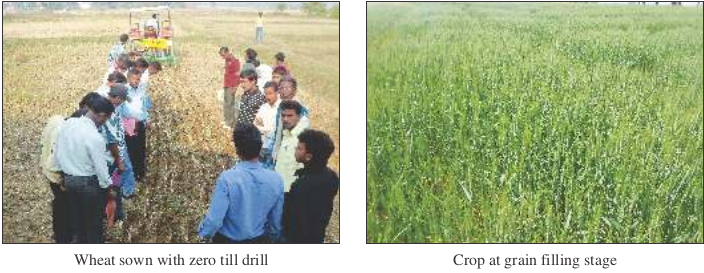Zero till drill wheat to escape terminal heat stress
Zero till drill wheat to escape terminal heat stress
Climate Vulnerability
Drought, Heat stress
Existing Practice
Wheat sowing by conventional methods requires multiple tillage operations to prepare a fine seed bed after harvesting of paddy crop. Generally, 2-3 or even more tillage operations are required which cost both time and money for the farmers. Moreover, shortage of time after paddy harvest to sow wheat creates uncertainty and delay in sowings. This sometimes results in moisture stress during the initial stages of crop growth eventually leading to poor yields. Impeded drainage in low lying fields makes it difficult for carrying out normal tillage operations. In such fields, late planting of wheat exposes the crop at critical stages to heat stress leading to decline in productivity.
Resilient practice / technology
Demonstrations of zero till drill sown wheat in farmers' fields were undertaken in several NICRA villages. The zero till drill not only saves tillage costs and energy but also eliminates the need for seedbed preparation. Zero till drilled wheat yields were on par with conventionally sown wheat. The machine operated with a 35 hp tractor can cover sowing of wheat in 4-5 ha/day.
Impact
Zero till sowing of wheat could save 68% in time and 85% on the cost of operation compared to the conventional practice. Zero till drill was more efficient as the crop could be sown in large areas within a limited time of moisture availability. The cost of zero till drill is Rs.45,000 to 60,000. The main advantages include:
- Saves irrigation water up to 10-15% during first irrigation.
- Two days early and uniform germination and better plant stand than traditional.
- No crust formation after rains, hence no effect of rains on germination.
- Improvement in crop yield.
- Improvement in soil structure and fertility.
- No lodging of crops at the time of maturity in case of heavy rains.
Now the farmers are convinced about the performance and benefits of zero till drill in NICRA villages. Demonstrations covered 851 ha and 1227 farmers using the zero till drill from the custom hiring centers established under NICRA. On an average yield advantage was in the range of 16 to 64% and benefit cost ratio was in the range of 2 to 3.2.

Scope for upscaling
Higher cost of implements is a major constraint in the large-scale adoption of zero till drill practice. State government subsidy can offset the cost to farmer to some extent. Such resource conservation technologies can be upscaled by establishing custom hiring service centers for costly farm machinery. The practice can be upscaled in rice-wheat cropping system areas.
Source: Smart Practices and Technologies for Climate Resilient Agriculture
Last Modified : 3/1/2020
This topic provides information about Community ta...
This topic provides information about Captive rear...
This topic provides information about Drought tole...
This topic provides information about Check dams f...
